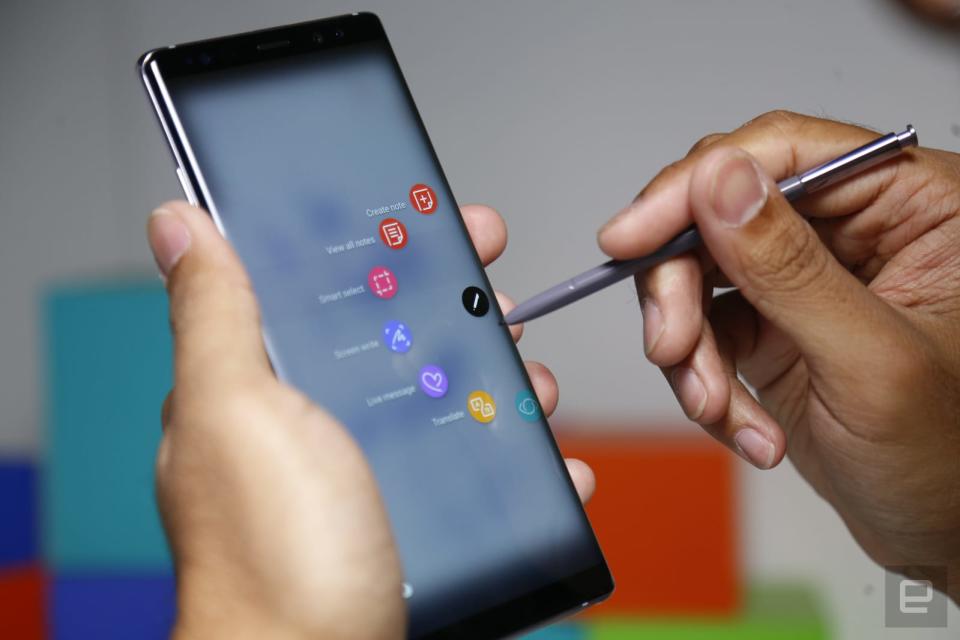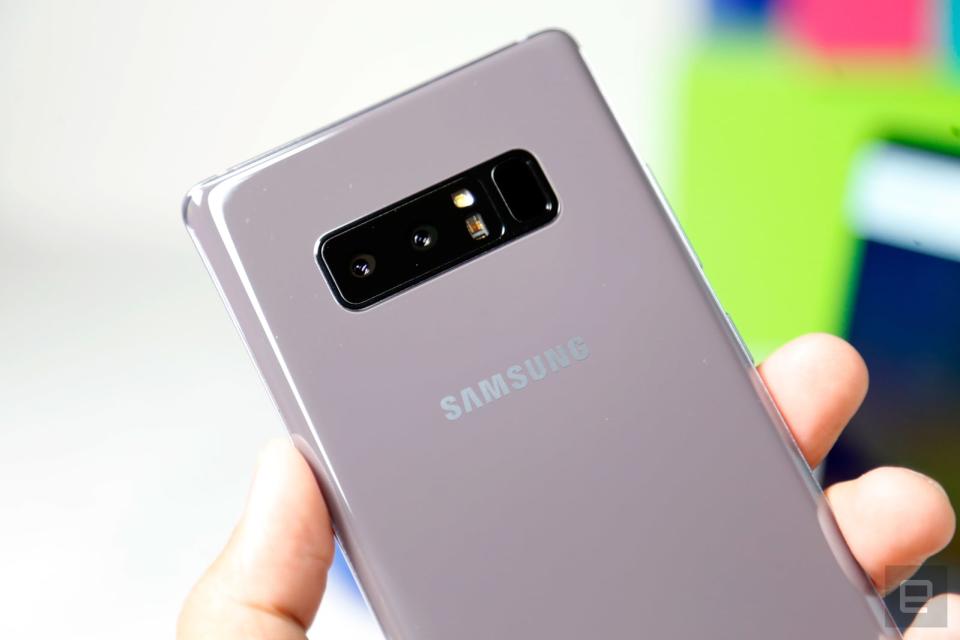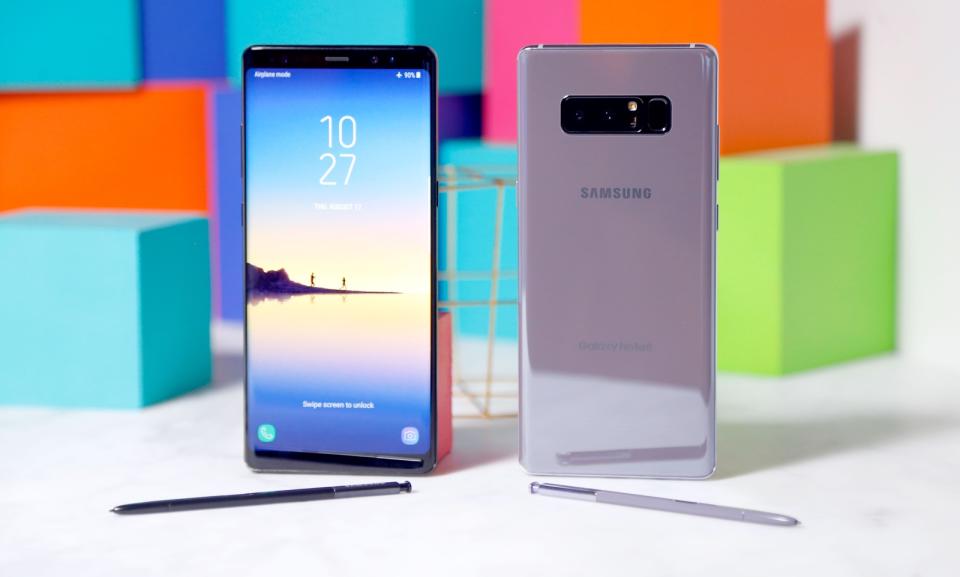Galaxy Note 8 hands-on: Enough to make you forget the Note 7
Samsung got even better at building big phones.
After the nightmare that was the Galaxy Note 7, few people would've been surprised if Samsung killed the Note line entirely. But it didn't. As an insane number of leaks have suggested, the company still believes the world needs a high-end phablet with an S Pen, and it took over a historic armory in New York to show off its latest attempt. Say hello to the Galaxy Note 8: a huge, beautifully made phone that just might be good enough to make people forget about its poorly designed predecessor.
There's a chance you've already decided you need a Note 8. If that's the case, just know that you can pre-order one starting on August 24th, and that the phone will officially go on sale September 15th. We're not sure about the price yet, but all five major carriers in the US will sell it, and an unlocked model will also be available at launch. Enjoy. We spent a little hands-on time with the Note 8 prior to today's event, so for everyone else, let's take a closer look.
Design-wise, the Galaxy Note 8 doesn't stray far from the foundation built by this year's S8 line. No surprise there. The phone's curved body is built from the same blend of metal and glass, and there's an octa-core Snapdragon 835 chip lurking inside, albeit with 6GB of RAM, up from 4GB on the S8. Based on our limited demo, the Note 8 seems to run the way a flagship should, even with all of Samsung's own software loaded on top of Android 7.1.1.
We're also working with the biggest display Samsung has ever squeezed into a Galaxy Note: a gorgeous 6.3-inch Super AMOLED panel running at Quad HD+ resolution. More important, the Note 8 manages to feel a little smaller than it actually is because there are basically no bezels on the sides of this enormous "Infinity" display. Not everyone will find a screen this big manageable, but hey -- that's basically true of every Galaxy Note.

The fit and finish are impeccable, too; the Note 8 is a remarkably sturdy-feeling machine, though the new Essential PH-1 has it beat when it comes to reassuring density. You'll find the fingerprint sensor on the Note's back, next to Samsung's first dual-camera setup, a USB-C port on the bottom and a headphone jack right next to that. In typical Samsung fashion, the Note 8 is rated IP68 for water- and dust-resistance, and there's a microSD slot to supplement the built-in 64GB, 128GB or 256GB of storage. (Sadly, we're getting only the 64GB model here in the US.)
Physically, the S Pen hasn't changed much since last year. It's water-resistant, just like the Note 8 itself, and recognizes the same 4,096 levels of pressure sensitivity as the Note 7. It's still not quite as satisfying as doodling pen on paper, but the level of precision is still impressive. The more notable changes come down to what you can do with the S Pen. The most notable (not to mention fun) addition is a feature called Live Messages. Basically, you can write out animated messages with the S Pen, lay them on top of pictures and export the whole shebang as a platform-agnostic GIF you can message to friends. We spent more time playing with this in our demo session than we probably should have, and the results are fabulous. These files can get large, though: The Live Message GIFs we made ranged from 10MB to 20MB.

Samsung also improved on S Pen features that we first saw on last year's model. With the Note 7 you could use the S Pen to highlight text you wanted to translate, but the Note 8 supports translating full sentences and snippets of text instead of just words. Dashing off notes on the screen while it's off still works, but you can now keep writing for up to 100 pages before having to save them to Samsung's S Note app.
Other features are geared toward using efficiently using all of the Note 8's screen space. Split-screen multi-tasking has been a thing since the early days of Android Nougat, and Samsung is capitalizing on that feature with what it calls App Pairs. Essentially, you can program two apps to launch in split-screen mode at the same time, if you're the type of person who likes, say, thumbing through lyrics in Genius while listening to Spotify. It's far from crucial, but hey -- we're sure someone will find it handy.
Really though, the biggest change is the camera. The Note 8 features Samsung's first dual camera (unless you count the leaked-but-unreleased Galaxy C10), and it combines a wide-angle 12-megapixel with an f/1.7 aperture with a 12-megapixel telephoto camera. We've seen these kinds of dual cameras before, most notably in LG's G-series phones, and they're generally more flexible than the color-and-monochrome sensor setups rival devices use. After some brief testing, it's clear that Samsung still knows what it's doing. Our test photos came through with remarkable color and clarity, and the 2x optical zoom also worked very well. We even got good-looking photos when we were shooting in the dim corners of Samsung's demo station. That's thanks in part to the optical-image stabilization found in both of the cameras, though the wide-angle camera's lens allows it to capture more light.

Having two cameras also means you can add some background blur to your photos using Samsung's Live Focus mode. Again, this isn't exactly new; Apple has its popular Portrait mode, and countless other phones have artificial bokeh features. What's neat about Samsung's approach is that you're able to control how much blur you want in your shot before and after you've taken the photo. We've dug a little more into the Note 8's camera performance here, but needless to say, Live Focus works very well. It's also worth noting that when you're shooting in Live Focus, you can also get the phone to take photos using both cameras at once, though only one of them appears in the gallery at a time. That this isn't a default photo option seems a little silly, so here's hoping Samsung fixes that in a software update. We're going to need more time to test the camera before drawing any hard conclusions, consider us optimistic. Samsung just might have built the dual-camera to beat.
As always, the Note 8 isn't going to be for everyone. It's undeniably big, and most people aren't really clamoring to use styluses with their phones. It does get a lot right, though, and anyone who was disappointed by the Note 7's sudden disappearance is sure to appreciate all these updates. OK, hardly anything about it was a surprise. That doesn't make the Note 8 any less impressive. We'll start working on our full Note 8 review as soon as we get one in for testing, but even at this early stage, the Note 8 seems poised to become the gold standard for big smartphones.
































